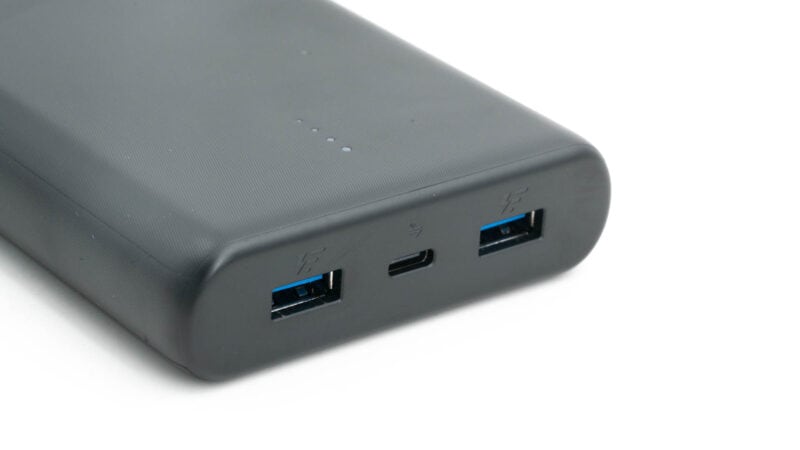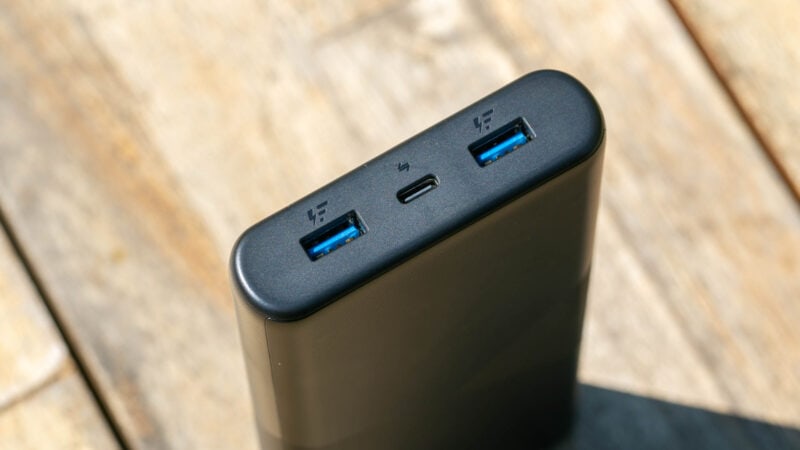With its „AmazonBasics“, Amazon offers its own products in many areas that are optimized for a particularly good price/performance. This also includes power banks.
The current „flagship“ powerbank from AmazonBasics offers a full capacity of 26800mAh and has a 45W USB C output. This sounds like a very fair deal for around 50€ at the time of testing.
But how does it look in practice? Can the Amazon Basics Powerbank with 26800mAh convince here? Let’s find out!
The Amazon Basics Powerbank with 26800mAh and 45W Power Delivery in test
The name Amazon „Basics“ really says it all with this powerbank, at least visually.
As for the casing, the powerbank is really very simple, to say the least. Amazon works with different textures that are supposed to make the powerbank a bit more interesting, but it is clear that it is optimized for price/performance.
The plastic used simply looks „cheap“ and the case can be pressed in a bit on the upper side.
The dimensions again fit for a powerbank of the 26800mAh class. The weight of 493 g is similar.
However, the equipment is especially interesting. The powerbank has two USB A ports and one USB C port.
The two USB A ports have the classic 5V/2.4A, which is 12W.
The USB C port, however, supports the Power Delivery standard with up to 45W! This means that the powerbank can not only charge smartphones quickly, but is also suitable for notebooks.
Likewise, the power bank can be recharged very quickly with up to 45W on a suitable charger, but more on that later.
The capacity
Amazon states the capacity of its powerbank as 26800mAh. In practice, I was able to measure the following:
| Wh | mAh @3,7V | % der HA | |
| 5V/1A | 87,989 | 23781 | 89% |
| 9V/1A | 81,635 | 22064 | 82% |
| 20V/1A | 81,918 | 22140 | 83% |
I could measure a capacity between 22064 mAh and 23781 mAh. This is a good result!
The capacity specification for powerbanks always refers to the capacity of the battery cells inside. However, discharging them is not 100% efficient. So there is always some loss in the form of heat, due to internal processes, voltage conversions, etc. This is especially true when using Quick Charge, USB PD or other fast charging standards. 80-90% is the common „good“ value for usable capacity. Above 90% is very rare and below 80% is unusual. Also keep in mind that your smartphone is not charging at 100% efficiency! If it has a 2000mAh battery, about 2600mAh is needed for a 100% charge. However, this depends somewhat on the model and the type of charging.
PPS
I was a bit surprised to find out that the Amazon Basics Powerbank supports the PPS standard!
PPS stands for Programmable Power Supply. The normal USB Power Delivery offers your smartphone several voltage levels, mostly 5V, 9V, 15V and 20V. Here it can choose one level and charge with it. PPS now allows your smartphone to freely choose a voltage within a certain range, for example 3.3-16V. If your smartphone thinks it would be ideal to charge at 6.5V, then a PPS charger can supply it with 6.5V.
Some smartphones like the Samsung S20/S21 series models require PPS to reach full charging speed. An S21 Ultra can charge at a maximum of 14W on a normal USB PD charger, and 25W on a PPS charger. If your smartphone does not support PPS, it will simply ignore this feature and treat the charger as a normal USB PD charger.
The Amazon Basics – Powerbank with 26800mAh has a PPS range of 3.3-20V at a maximum of 2.2A. Thus, the range is quite large, but the power with a maximum of 2.2A is rather small and can limit the charging speed somewhat in practice. Nevertheless, the PPS is available at all, which is great!
The charging speed
I tried the following devices on the Amazon Basics Powerbank with 26800mAH:
| USB C | USB A | |
| Apple iPad Pro 11 | 26,94 | 4,7 |
| Apple iPhone 12 Pro | 17,8 | 8,2 |
| Samsung Galaxy S21 Ultra | 24,4 | 7,3 |
| Nintendo Switch | 16,39 | 7,3 |
| Dell XPS 13 9380 | 43,2 |
There are no big surprises here, as all connected devices were charged cleanly and at a good pace.
Thanks to the support of the Power Delivery and PPS standards, the powerbank is also ideally suited for the Samsung S20 and S21 smartphones.
The USB C port also has enough power to charge one or the other notebook at a decent speed with 45W.
Recharge speed
The powerbank can be charged with up to 45W on a power delivery charger. However, this is only half the truth.
Thus, a full charge of the powerbank takes around 4 hours in the optimum case. However, the powerbank only charges for 1 hour of these 4 hours with 45W. Most of the charging went with just over 30W.
Nevertheless, 4 hours of charging time on a suitable 45W USB PD charger is okay so far.
Conclusion
Although I find the design and also the feel of the powerbank rather moderately good, but I can still make a recommendation!
This is mainly due to the technology of the Amazon Basics Powerbank with 26800mAh. The 45W USB C port delivers what it promises and even more, thanks to the support of the PPS standard.
This allows the powerbank to charge significantly more smartphones at full speed, like Samsung’s S20 and S21 series models.
In addition, it has a decent real capacity of 22xxx – 23xxx mAh and a fast recharging speed. The powerbank goes from 0% to 100% in about 4 hours, as long as you use a USB PD charger with 45W.
Ultimately, it also depends somewhat on the price! At the time of the test, the powerbank is available for under 50€ (the price may have changed in the meantime!). +- 50€ for a 26800mAh powerbank with 45W USB PD output is absolutely fine!
Clearly your budget is „unlimited“ I would rather reach for an Anker PowerCore III Elite, but as far as the price / performance is the Amazon Basics Powerbank with 26800mAh class!
Update: The powerbank is now available again!
Link to the manufacturer /// at Amazon









Hello, I’m considering this power bank, is it compatible with Quick Charge fast charging protocol and does it fast charge the Galaxy S22 Ultra?